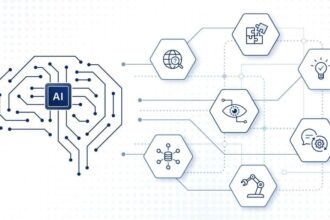Artificial intelligence has always been synonymous with disruption, but in 2025 the pace of transformation is staggering. Once limited to research labs and niche applications, AI now touches almost every corner of business and daily life. From autonomous digital agents that manage workflows to AI-driven influencers shaping consumer behavior, the technology is evolving at breakneck speed.
For professionals, entrepreneurs, and policymakers alike, keeping track of AI’s trajectory isn’t optional—it’s essential. Below, we explore seven game-changing AI trends in 2025 that are reshaping industries, redefining work, and creating new ethical challenges.
1. Agentic AI: From Assistants to Autonomous Colleagues
The era of AI assistants like chatbots and voice-driven search is giving way to Agentic AI—autonomous systems capable of planning, learning, and executing complex tasks with minimal oversight.
Unlike earlier models, these AI agents can manage projects end-to-end, coordinating across apps, data sources, and even physical robotics. In logistics, they’re scheduling shipments; in finance, they’re optimizing portfolios; in offices, they’re functioning as virtual coworkers.
👉 Why it matters: Agentic AI doesn’t just reduce repetitive work—it reshapes organizational structure, blurring the lines between human and machine labor. (McKinsey)
2. AI Infrastructure Explosion
Behind every AI breakthrough lies massive compute power. By 2025, AI infrastructure is one of the fastest-growing sectors in tech, with hyperscale data centers, cloud services, and custom silicon driving growth.
NVIDIA, AMD, and a wave of startups are racing to supply GPUs, TPUs, and AI-specific chips to handle unprecedented demand. Industry analysts project multi-trillion-dollar investments in AI infrastructure by 2030, underscoring just how central AI will be to the global economy.
👉 Why it matters: Cheaper, faster compute unlocks innovation for smaller firms, democratizing access to powerful AI previously reserved for Big Tech. (Reuters)
3. Efficiency Breakthroughs and AI Democratization
Between late 2022 and 2024, the cost of running GPT-3.5-level models dropped over 280-fold. Hardware advances, software optimization, and the rise of open-weight models are making AI both cheaper and more accessible.
This efficiency shift means small businesses, independent developers, and even individuals can run models that rival enterprise-level systems of just a few years ago.
👉 Why it matters: Democratized AI levels the playing field, allowing startups and solo creators to compete with corporations. (Stanford AI Index 2025)
4. Multimodal AI and Hyper-Personalization
2025 is the year multimodal AI goes mainstream. These systems integrate text, speech, images, and video into unified experiences. Imagine an AI that reads a legal contract, analyzes tone in a client meeting, and generates a visual explainer—all in one workflow.
Retailers use multimodal AI for hyper-personalized shopping, healthcare providers for diagnostics, and governments for smarter public services.
👉 Why it matters: Multimodality enables richer, context-aware interactions, making AI more intuitive, responsive, and human-like. (Google Cloud)
5. Explainable and Trustworthy AI
As AI systems make more consequential decisions, transparency is critical. Enter Explainable AI (XAI)—an emerging field that helps users understand why an AI made a particular choice.
Meta-reasoning techniques are improving interpretability, enabling businesses to audit AI behavior for compliance and ethics. Regulators, investors, and customers are demanding accountability like never before.
👉 Why it matters: Without explainability, AI adoption risks eroding trust. With it, AI becomes a trusted decision-making partner.
6. Regulation and Human Oversight
AI’s rapid expansion has triggered global policy responses. The EU AI Act is setting the tone with a risk-based framework, requiring transparency, human oversight, and restrictions on high-risk applications. Similar regulations are under discussion in the U.S., China, and beyond.
For businesses, compliance isn’t optional—regulatory literacy is now a competitive advantage. Companies that embed ethics, safety, and transparency into design will have smoother adoption and fewer legal risks.
👉 Why it matters: Regulation defines not just what AI can do, but what it should do in society.
7. AI in the Creator Economy: Virtual Influencers and Companions
AI is also redefining culture. In 2025, AI-generated influencers dominate Instagram campaigns, offering brands 24/7 scalable engagement without human unpredictability. Meanwhile, AI companion apps—digital friends, mentors, or even romantic partners—are gaining millions of users.
These innovations raise profound questions: What does authenticity mean when your favorite influencer isn’t real? What happens when people build emotional bonds with AI companions?
👉 Why it matters: Beyond business, AI is reshaping identity, relationships, and culture itself.
Final Thoughts: AI at a Crossroads
The future of AI in 2025 is not just technological—it’s societal. These seven trends reveal a world where AI is no longer an add-on but a core operating system of modern life.
For innovators, the opportunities are immense. For regulators, the stakes are high. And for individuals, the challenge is clear: learn to work with AI, not against it.
Key Takeaways
- Agentic AI is turning assistants into autonomous collaborators.
- AI infrastructure investment is fueling economic growth and access.
- Efficiency breakthroughs are democratizing powerful AI tools.
- Multimodal AI enables hyper-personalized, context-rich interactions.
- Explainability is critical for trust and adoption.
- Regulation is shaping the rules of engagement for AI globally.
- AI in culture—from influencers to companions—is blurring reality and reshaping human interaction.








